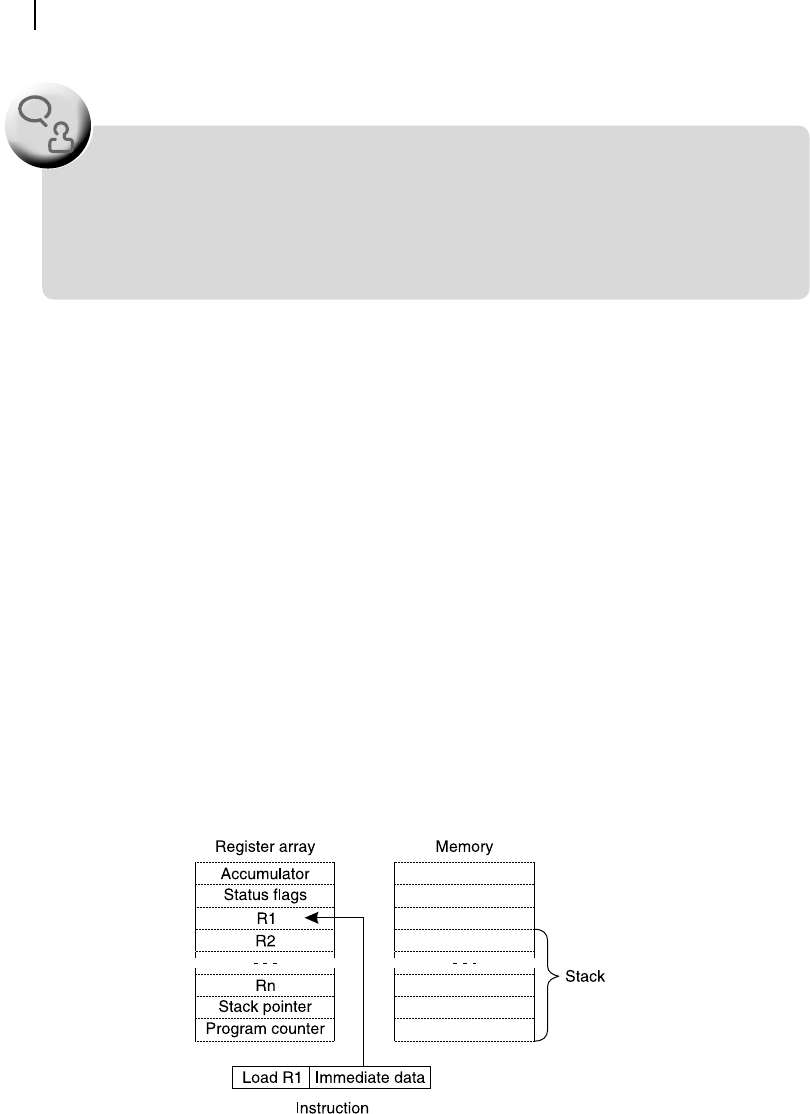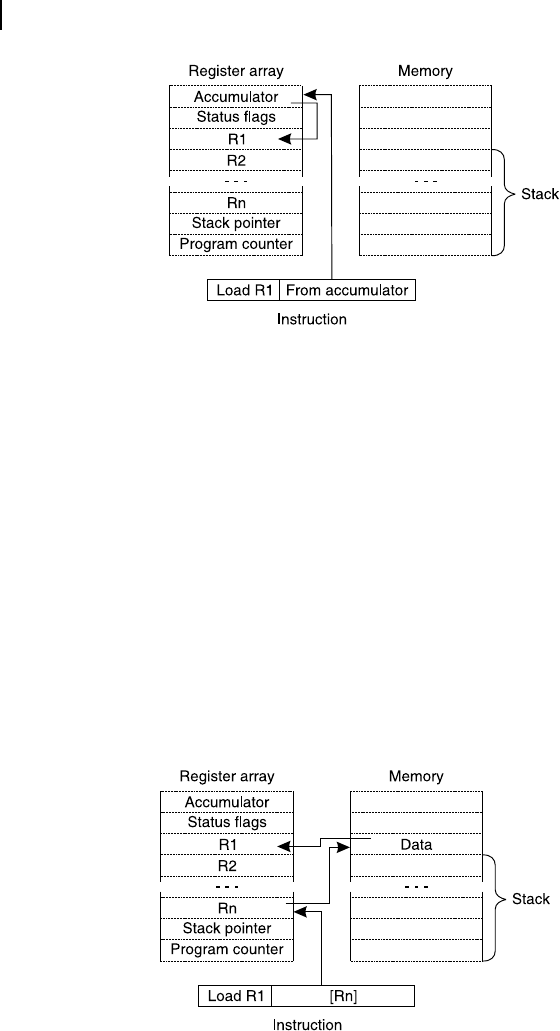
Instruction Set and Assembly Language Programming 155
Instruction Function
AND Logically AND two operands
OR Logically OR two operands
XOR Logically XOR two operands
NOT Complement the operand
Shift right Shift operand right one bit. LSB is lost. New constant introduced at MSB.
Shift left Shift operand left one bit. MSB is lost. New constant introduced at LSB.
Rotate right Shift operand right one bit. LSB is shifted to MSB.
Rotate left Shift operand left one bit. MSB is shifted to LSB.
Compare Compare two operands and re ect the result through ags
Test Test ag bit(s)
Table 6.3 Common logical type instructions for processors
Instruction Function
Branch unconditional Jump to the indicated address
Branch conditional Test condition and if condition is true then jump to indicated address
Call a subroutine Save PC on stack-top and branch to indicated address
Return from subroutine Reload PC by address saved on stack-top
Return from interrupt Enable interrupts and reload PC from stack-top
No operation Do nothing
Wait Wait for a signal input
Halt Stop functioning of the processor
Skip next instruction Execute the instruction immediately after the next instruction
Branch relative to PC Add PC with an offset and branch there
Table 6.4 Common program flow control type instructions for processors
6.4 ADDRESSING MODES
Addressing modes are generally related with data transfer type instructions and indicates the method by
which the data are targeted by the instruction. For example, we need to load a set of data in a register.
However, the concerned data might be a part of the instruction itself or it might be already available
at some external memory address or within an internal register of the processor. Depending upon the
method by which it is located, it would be the addressing mode of that instruction that loads that data
in the register. The following are some of the widely used addressing modes by different processors:
R Immediate
R Direct
R Register direct
M06_GHOS1557_01_SE_C06.indd 155M06_GHOS1557_01_SE_C06.indd 155 4/29/11 5:09 PM4/29/11 5:09 PM

156 Computer Architecture and Organization
R Register indirect
R Relative
R Implicit
R Indexed
Brief discussions of these modes are presented below. Remember that all addressing modes are not
offered through all processors. Moreover, maximizing the number of addressing modes would make the
instruction decoding procedure of the processor more complex. It is on account of this reason for RISC
processors to offer lesser number of addressing modes.
6.4.1 Immediate
In an immediate addressing mode, the target data are a part of the instruction. As it is so, to change the
data, the instruction itself has to be changed. That is the reason for which the immediate addressing
mode is referred to as loading a ‘ constant ’. Depending upon the processor, these data might be integers
(unsigned or signed) or real. An example of immediate addressing mode instruction for 8085 processor
may be
LXI H, 1234H,
which loads the register pair HL by 16-bit data 1234H.
The student should note that addressing mode is not applicable for all instructions. For
example, the NOP (no operation) instruction can not have any addressing mode as it has noth-
ing to do with any data, either loading or storing it. Addressing modes are important for the
instruction set architecture level and particularly for instruction decoding. However, ‘every
instruction of a processor must be having an addressing mode’ is a false notion.
F
O
O
D
F
O
R
T
H
O
U
G
H
T
Figure 6.2 Example of immediate addressing mode
M06_GHOS1557_01_SE_C06.indd 156M06_GHOS1557_01_SE_C06.indd 156 4/29/11 5:09 PM4/29/11 5:09 PM

Instruction Set and Assembly Language Programming 157
Figure 6.2 illustrates the immediate addressing mode using an imaginary processor as an example
case. In this case, the instruction Load R1 by immediate data is executed by loading R1 by the data,
which is a part of the instruction itself.
6.4.2 Direct
In a direct addressing mode the target data’s location or the present address of data becomes a part of the
instruction. In other words, the data we are interested about are already available in a memory location
and the address of that memory location is already known to us. In the data loading instruction, we refer
that address and the processor, during execution of the instruction, retrieves that data from the known
address and places it at a proper place, as intended. In majority of cases, this type of data would be vari-
ables, as we may store or change the data located within that known address. Using 8085 instruction set,
an example of direct addressing mode would be
LDA 1234H,
which loads the accumulator directly from the content of the memory location whose address is 1234H.
Figure 6.3 Example of direct addressing mode
Figure 6.3 illustrates the direct addressing mode, where the address of the data is shown as a part
of the instruction itself. According to the instruction, the processor copies the content of the addressed
location to the destination register, which is R1 in this case.
6.4.3 Register Direct
In register direct addressing mode, the name of the register, bearing or holding the target data, is indi-
cated in the instruction. In general these instructions are shortest in length as they need not contain a
complete address or complete data, necessary in direct and immediate addressing modes respectively.
However, in case of those processors, which offers multiple register banks with identical register names,
proper bank must be selected before implementing such instructions. An example of register direct
addressing mode from 8085 instruction set may be
MOV A, C,
which would copy the data from register C to the accumulator.
For some processors, three registers are used in the register direct addressing mode. The third regis-
ter in that case is indicated to hold the result. For example, we need to add two integers present in two
M06_GHOS1557_01_SE_C06.indd 157M06_GHOS1557_01_SE_C06.indd 157 4/29/11 5:09 PM4/29/11 5:09 PM

158 Computer Architecture and Organization
registers and place the result in a third register. Names of all three registers would be indicated by the
instruction in such a situation. However, this facility is not available in all processors.
Register direct addressing mode is illustrated in Figure 6.5 , where the source and destination regis-
ters are indicated for the data-copy operation. In this case, the accumulator is considered as the source
of data to be copied to the general purpose register R1.
6.4.4 Register Indirect
In register indirect addressing mode, also, the instruction indicates a register’s name. However, unlike
the previous case, the indicated register holds the address of the target data. Instead of providing the
complete address of the data (as done in direct addressing mode), indicating just the name of the reg-
ister that holds that address makes the length of the instruction shorter. An example of register indirect
addressing mode for 8085 instruction set may be
MOV A, M.
Execution of this instruction would load the accumulator from the memory location whose address is
available in register pair HL of the processor.
Figure 6.4 Example of register direct addressing mode
Figure 6.5 Example of register indirect addressing mode
In Figure 6.6 , an example of register indirect addressing mode is illustrated, where it is assumed that
the register R
n
is capable of holding the address of the source data. During the execution of the instruc-
tion, the data available within the address as indicated by the content of Rn are copied into R1.
M06_GHOS1557_01_SE_C06.indd 158M06_GHOS1557_01_SE_C06.indd 158 4/29/11 5:09 PM4/29/11 5:09 PM

Instruction Set and Assembly Language Programming 159
6.4.5 Relative
In relative addressing mode the location of target data is speci ed with respect to the current position
of the program counter (PC). In other words, the instruction would be similar to, e.g., nd the data after
20 bytes from now. Here, now means present content of PC. Generally, this type of addressing mode is
used for a table look up in a suitable subroutine.
An example of relative addressing mode is illustrated in Figure 6.6 , where the instruction indicates
to load a byte of data into register R1. The location of the data is expressed in relative addressing mode,
which, in this example case, is seven locations away from the current value of the program counter
of the processor. Therefore, to get the data, the current value of PC is incremented by 7 (PC remains
unchanged) and the resultant location is used as the source of the data to be copied to R1.
Figure 6.6 Example of relative addressing mode
The relative addressing mode offers one advantage. Even when the address of the program is
changed, it would still correctly nd the data out as the location of data is expressed as an offset of the
current value of PC. Relative addressing mode is used extensively in conditional jump instructions of
8051. However, it is not used in 8085 instruction set.
6.4.6 Implicit
In implicit addressing mode, the location of data is not indicated in the instruction because, for the implicit
instruction, the location of data is prede ned. For example, an imaginary processor might offer an instruction
CLEAR, which is applicable only for the accumulator of that processor. Whenever the accumulator has to be
loaded with 0s, this CLEAR instruction may be used. As we see, no operand is indicated in the instruction
as the name of the accumulator is implied and no other location would be cleared by this instruction. Widely
used instruction RETURN (or RET in some cases) falls under this category. In this case, it is implied to get
the relevant data (to be used as return address) from the stack top as pointed by the stack pointer (SP).
Another frequently used instruction using implicit addressing mode is POP, i.e., to restore a data
from stack-top to some indicated location. The source of data to be POPed is implicitly indicated as the
present stack-top location. This is illustrated through Figure 6.7 by the instruction POP R1. According
to the instruction, the data are located with the help of the stack pointer (SP) at the stack-top and then
M06_GHOS1557_01_SE_C06.indd 159M06_GHOS1557_01_SE_C06.indd 159 4/29/11 5:09 PM4/29/11 5:09 PM
..................Content has been hidden....................
You can't read the all page of ebook, please click here login for view all page.
